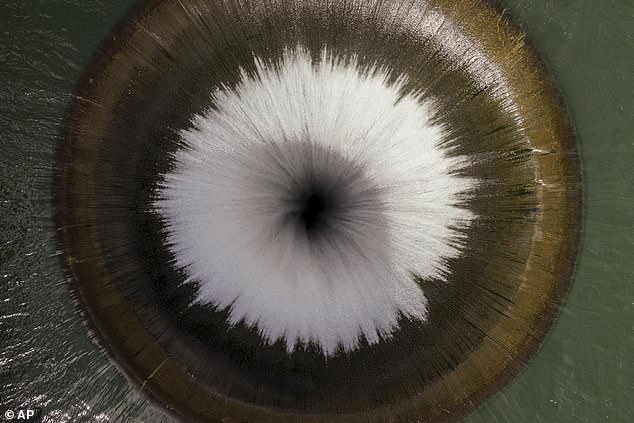
Lake Berryessa’s ‘Glory Hole’ Spillway Activates After 5-Year Hiatus Due to Heavy Rains
Napa County’s “Glory Hole” Spillway Activates After Heavy Rains
(Word count: ~600)
[Image 1: The Morning Glory spillway in action, resembling a flower. Caption: The spillway’s “spillover” creates a striking resemblance to a morning glory flower, earning its official name.]
Lake Berryessa’s iconic “glory hole” spillway has begun draining excess water for the first time since 2019, drawing crowds to witness the rare phenomenon. The 72-foot-wide drain, officially named the Morning Glory spillway, activates when the lake’s water level surpasses 440 feet, funneling water 200 feet down into Putah Creek to prevent flooding.
This winter’s relentless atmospheric rivers filled the lake to capacity by early February, triggering the spillover. The spectacle, nicknamed “glory hole” by locals in the 1960s, occurs only about 25 times in its 70-year history.
[Image 2: Tourists gather at a highway turnout. Caption: Visitors flock to Highway 128 to safely watch the rushing spillover.]
“It’s definitely worth seeing,” said Chris Lee of the Solano County Water Agency. “It’s just not that common.” The current spillover has lasted over 40 days, with water levels still six inches above the threshold as of mid-March. Lee predicts it may subside soon but notes rain could prolong the event.
Engineering and Safety
Built between 1953–1957 alongside Monticello Dam, the spillway’s design ensures “laminar flow”—smooth, layered water movement—to avoid dangerous whirlpools. A buoy line keeps boats and swimmers at a safe distance.
[Image 3: Water cascades into the drain. Caption: The spillway’s laminar flow design prevents whirlpools, though one fatal accident occurred in 1997.]
Despite precautions, tragedy struck in 1997 when a woman was swept into the drain. It remains the only recorded fatality linked to the structure.
Purpose and Popularity
Lake Berryessa provides irrigation for farms and drinking water to 500,000 residents. Spillovers can last months, like in 2017 when drainage persisted from February to May.
[Image 4: Aerial view of the spillway and dam. Caption: The glory hole sits 200 feet from Monticello Dam, completed in 1957.]
For now, the glory hole remains a mesmerizing natural-engineering hybrid, showcasing nature’s power and human ingenuity. Visitors are urged to admire it from designated areas, where the roar of cascading water serves as a reminder of both its beauty and force.
(End of condensed article. Image credits: Daily Mail, as referenced in original text.)


